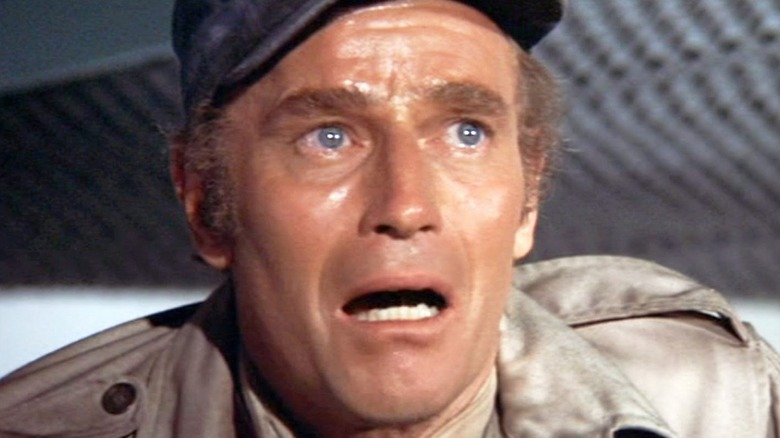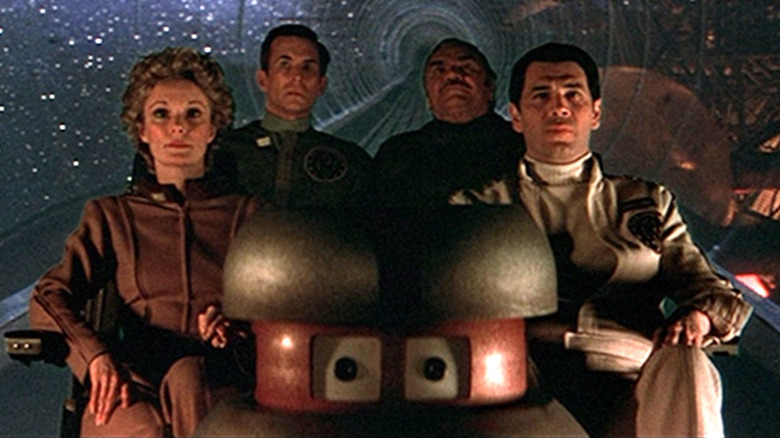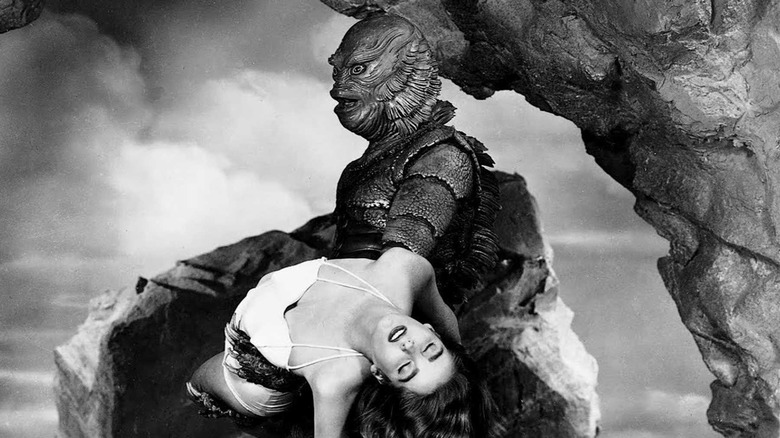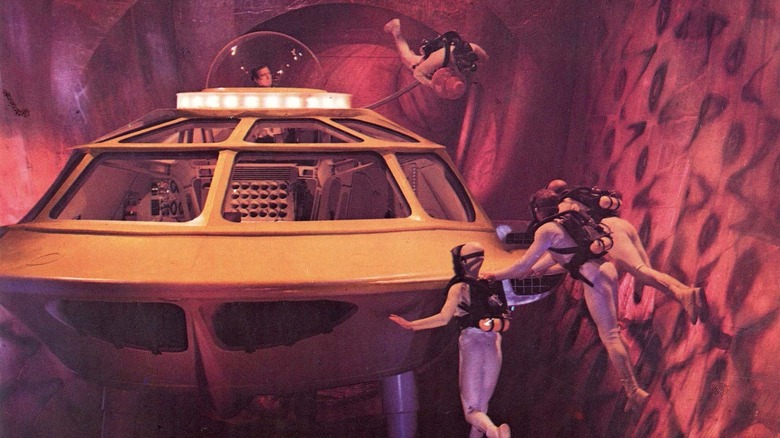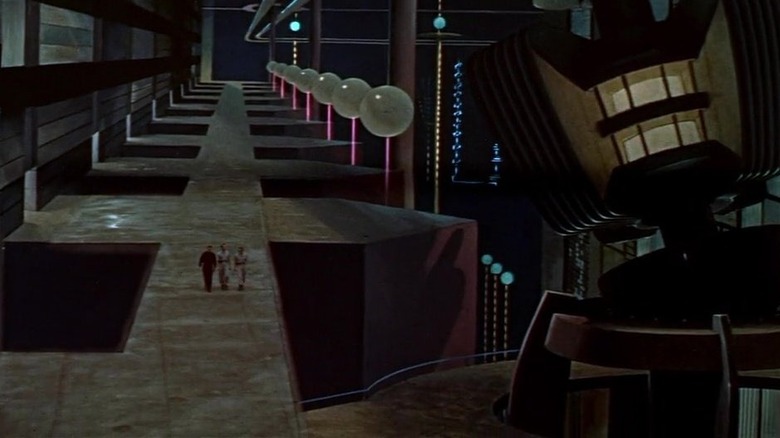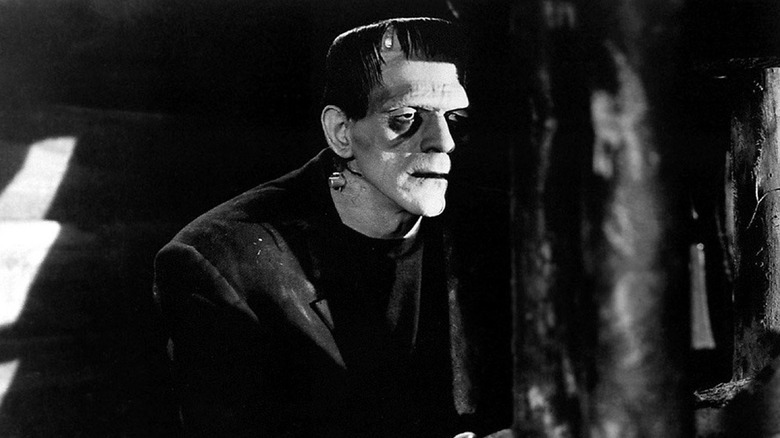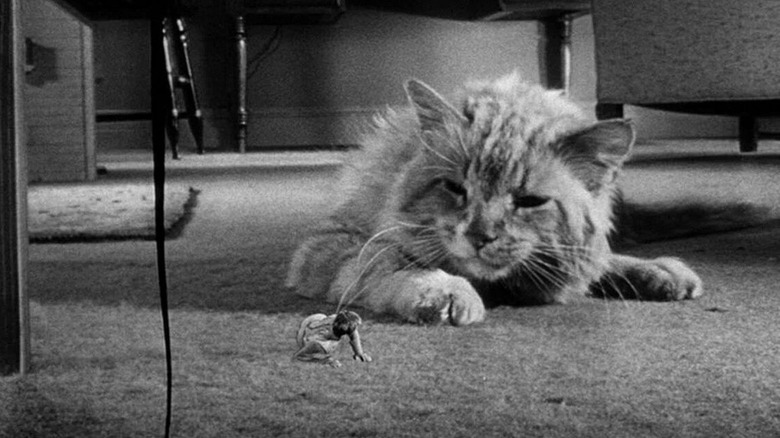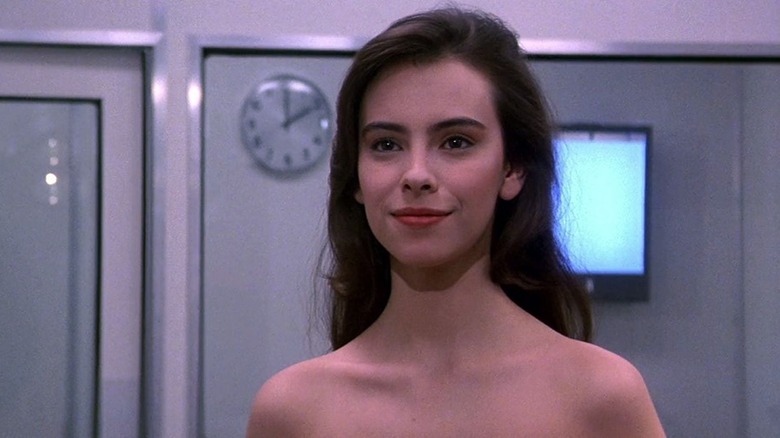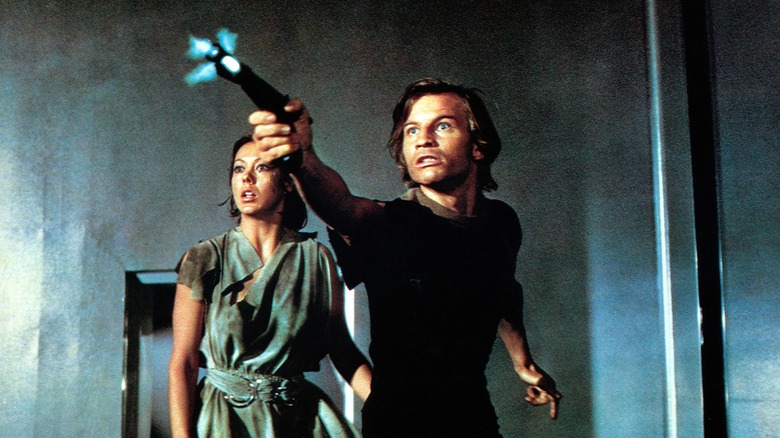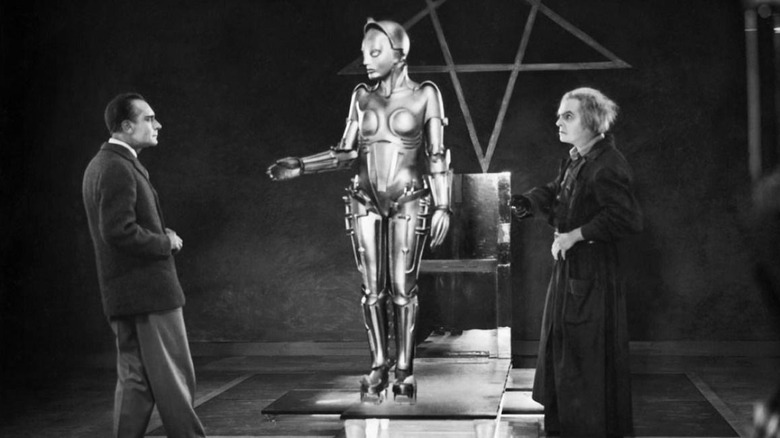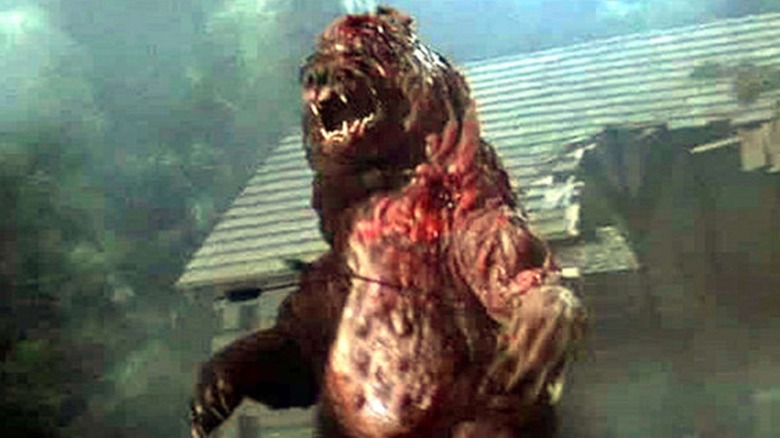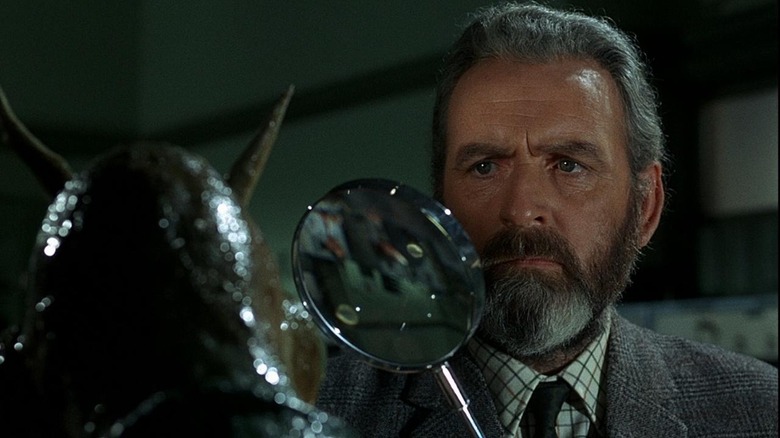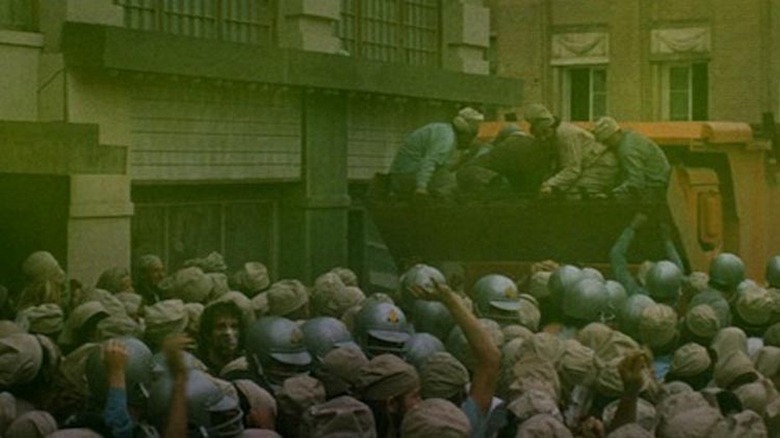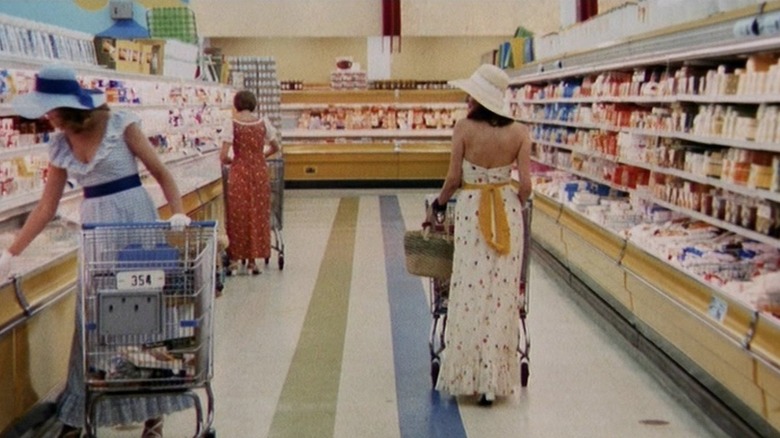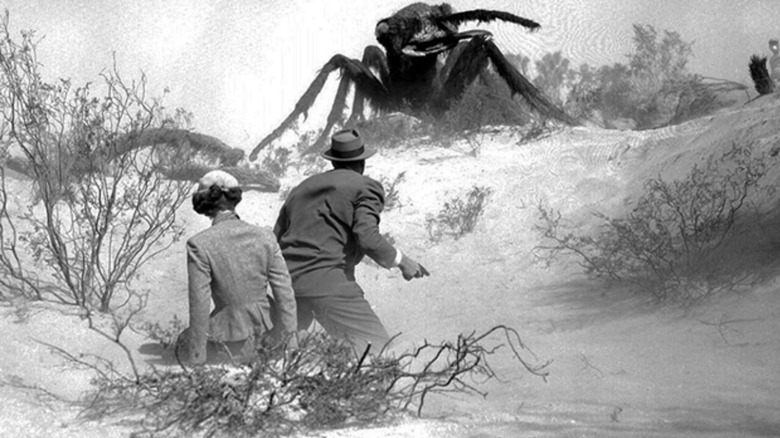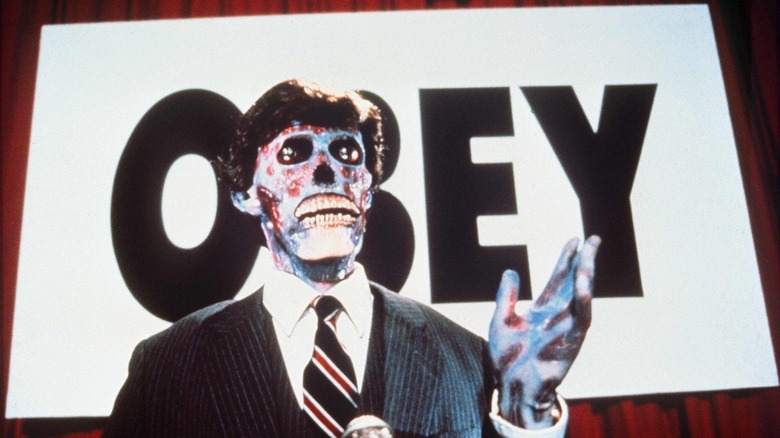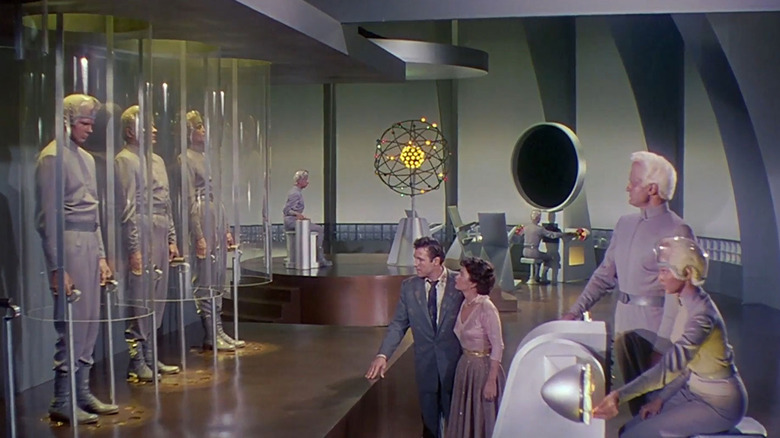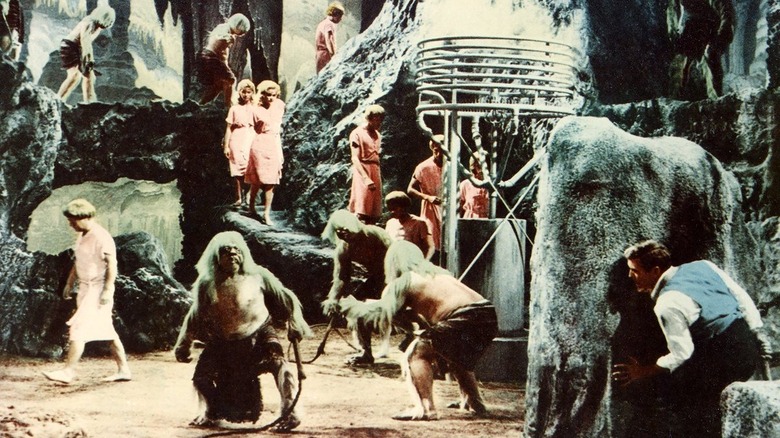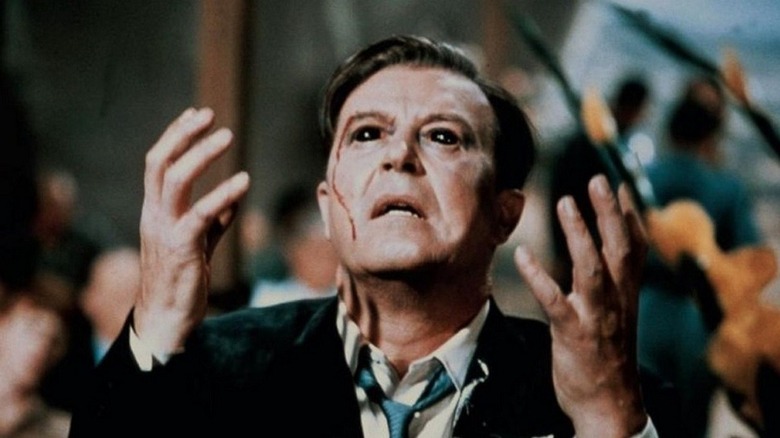Sci-Fi Classics That Could Use A Remake
Although director Denis Villeneuve's big-screen adaptation of "Dune" is not technically a remake of the 1984 David Lynch film — since both are based on the 1965 Frank Herbert novel — it is in many ways a significant upgrade from the former troubled production. Whatever one may think of Lynch's film — and it has both defenders and detractors — it was an ambitious attempt to bring an epic sci-fi vision to life with limited resources in terms of budget, visual effects, technology, and more.
Hey, you might not care for the newest version either. But with considerably more money (reportedly $165 million) and visual effects wizardry to work with, it's hard to argue that Villeneuve's film doesn't look and sound much better than the Lynch effort. Production values from 1984 simply don't hold a candle to what is available today to top Hollywood directors. It's not just the surface of the film: acting or narrative choices made decades ago might not play as well with today's audiences either.
Seeing what was accomplished with "Dune," there are many more legitimate sci-fi classics that could be given a new lease on life through the advanced production capabilities at Hollywood's disposal. Some are actually in development already (or have been), while others have yet to be pursued. Yes, one can grow uneasy at the thought of Hollywood "re-imagining" a film beloved by previous generations of fans, but if updating the material for today's audiences re-introduces a classic tale or even leads a few intrepid viewers back to the source, that's worth a shot, isn't it?
The Black Hole
Disney's 1979 space opera was heavily publicized at the time for being the Mouse House's first PG-rated movie, with the company looking to get in on some of that sweet sci-fi money generated by the likes of "Star Wars" and "Close Encounters of the Third Kind." But despite a notable cast (including Anthony Perkins, Maximillian Schell, and Ernest Borgnine) and some dazzling special effects, "The Black Hole" was criticized as too derivative of "Star Wars" — right down to its cute trio of robots and the mad scientist's legion of stormtroopers, sorry, drones — and hampered by a silly script.
While the science itself may be wonky even today — human beings in all probability could not survive a trip through a black hole — the metaphysical ideas behind such a voyage, which takes place at the film's climax, remain interesting and have informed recent blockbusters like "Interstellar." With a better script, a decent cast, and the vast resources of Lucasfilm — which Disney now, ironically, owns — available, "The Black Hole" could probably be modernized into a thrilling cosmic adventure. In fact, Disney thought so too: director Joseph Kosinski and writer Jon Spaihts were hired to remake it in 2009, although Spaihts later revealed that his script was "too dark" for the studio. A new script was commissioned in 2018, according to Coming Soon, but little has been heard since.
The Creature from the Black Lagoon
Although the Gill-man emerged from the Amazon in the 1950s, long after the initial wave of Universal horror movies that hit in the 1930s and '40s, the Creature from the Black Lagoon has generally been grouped with the rest of the classic Universal monsters. His first film, released in 1954 and directed by sci-fi auteur Jack Arnold (more on him later), was successful enough to spawn two sequels: 1955's "Revenge of the Creature" and 1956's "The Creature Walks Among Us." The original is easily the best, with the genuinely creepy Creature rising from the depths of the river to terrorize a boatload of explorers and lust after token female crew member Julie Adams.
A remake of the original film has been in the works as far back as 1982, and over the years, directors such as John Carpenter, Ivan Reitman, and Guillermo Del Toro have all either been involved in its development or offered the director's chair (Del Toro arguably offered his take on the same concept with his Oscar-winning "The Shape of Water"). The Creature was potentially going to be included in Universal's "Dark Universe" series of films, until that fell apart.
The central metaphor of the Creature — nature fighting back against the encroachment of civilization — is perhaps even more relevant today, with the Amazon rainforest being systematically destroyed, and modern special effects could likely create a truly eerie new version of the monster. We remain hopeful it happens one day.
The Day of the Triffids
"The Day of the Triffids" is one of the titles on this list that has had several turns at bat screen-wise: John Wyndham's 1951 novel, in which much of the human race is blinded by a meteor shower and comes under siege from monstrous flesh-eating plants, was filmed in 1962, adapted several times for radio, and made into two British TV miniseries in 1981 and 2009. Wyndham is regarded as one of the greatest British sci-fi writers of all time, which is perhaps why "Triffids" gets rebooted every few decades.
The 1962 film is not particularly faithful to the novel, while the 1981 TV version has extremely dated special effects. Although the triffids themselves have been and could be difficult to translate effectively to the screen, a skillful director and production team could get the job done, especially if the film stays true to the dread-inducing atmosphere of the book and its detailing of the breakdown of society. For audiences who have not seen any of the previous versions, a fresh re-imagining of "Triffids" could provide a brand-new twist on a familiar post-apocalyptic scenario. Sam Raimi launched a winning bid for the rights in 2010, but a new version has yet to, uh, sprout.
Fantastic Voyage
The science in this 1966 Oscar winner is absolute junk (science fiction writer and biochemistry professor Isaac Asimov even tried to fix it in the novelization of the screenplay that he wrote), but there's still something utterly compelling about the idea of shrinking a team of scientists down to microscopic size so that they can enter another human being's body and perform delicate surgery to save his life.
The images inside the human body, as the tiny ship bearing the medical team travels through the patient's heart, battles white blood cells and lasers a blood clot off the man's brain, were still pretty impressive for the time (as was Raquel Welch in a snug white outfit in her first major Hollywood role), but clearly a modern remake could do dazzling wonders with this material. Major writers and filmmakers agree: Asimov himself was approached to write a sequel in 1984, choosing instead to write his own unrelated novel, while James Cameron, Roland Emmerich, Paul Greengrass, Shawn Levy, David S. Goyer, and Guillermo Del Toro have all been attached at different times to a full-blown remake. Del Toro's version, produced by Cameron from a script by Goyer, was supposed to begin production in 2018 — but we're still waiting.
Forbidden Planet
A crew aboard an interstellar ship, led by a brave, confident captain, investigates the fate of an expedition sent to explore a new planet 20 years earlier. They encounter just two survivors: a scientist named Morbius and his young daughter Altaira. Morbius reveals that he has discovered the remnants of a vastly superior race called the Krell, who developed powerful mental abilities before disappearing some 200,000 years ago. When a strange force begins attacking the crew, the captain must discover the connection between the presence, Morbius and the Krell.
If this sounds like it could be an episode of "Star Trek," that wouldn't be far off the mark. "Forbidden Planet," released in 1956, is one of the most influential sci-fi movies of all time. It introduced concepts and scenarios that found their way into not just "Trek," but "Star Wars," "Alien," and countless others. According to Inverse, one could claim that every sci-fi movie released in the past six decades owes something to "Forbidden Planet."
One of the most intelligent genre pictures of its time, it holds up surprisingly well today — even the visuals are pretty good for a 65-year-old film. The narrative (based loosely on Shakespeare's "The Tempest") is rich enough to provide the bones for an even more technologically impressive reboot — with a few tweaks (such as the men's attitude toward Altaira and her own rather precocious sexual innocence). "Babylon 5" creator J. Michael Straczynski developed a remake back in 2008 for Warner Bros. Pictures, but by 2009 the project had been abandoned.
Frankenstein
Yeah, we know. There are about 10 million versions of the "Frankenstein" story or even just the Frankenstein monster already available, ranging from the 1910 short, silent version (widely acknowledged as the first screen adaptation) all the way to a 2019 modern retelling of the story directed by cult horror auteur Larry Fessenden. But while plenty of these movies (including classics like 1931's "Frankenstein" and 1957's "The Curse of Frankenstein," as well as an obscure, modernized 2015 version helmed by original "Candyman" director Bernard Rose) have something to offer, there has yet to be a definitive, uncontestable adaptation of Mary Shelley's landmark 1818 novel.
We know Guillermo Del Toro's wanted to make it for a long time (since 2009 at least), and we suspect that his version would possibly be the final word on the subject, but there's no telling when he'll get around to it. It would be quite startling to see a truly faithful retelling of this atmospheric Gothic tale, drenched in dread and forbidden science, with a version of the creature as described by Shelley — the ultimate sci-fi and horror hybrid.
The Incredible Shrinking Man
The idea of miniaturizing humans seems more like fodder for comedic material these days (we're looking at you, "Honey, I Shrunk the Kids" and "Ant-Man"), but it was the basis of an existential horror/sci-fi classic in Richard Matheson's 1956 novel, "The Shrinking Man." Filmed a year later by sci-fi auteur Jack Arnold, the story follows a middle-class ad executive (read: straight white married male) named Scott Carey who begins to diminish in size after he is exposed to a cloud of mysterious radiation.
Both the book and movie are remembered for Carey's terrifying battles with his once-beloved cat and a spider lurking in the basement where Carey finds himself trapped. But there's also a rich subtext about what it means to be a man (Carey's relationship with his wife does not fare well) and what it means to be human — with an ending that catches you by surprise with its profundity. The 1957 film's effects have not aged well, so a well-crafted remake could be very effective — and, at a time when many of us may feel lost in a chaotic world, even more profound.
Matheson himself wrote a treatment for a sequel, according to Bill Warren's "Keep Watching the Skies!: American Science Fiction Movies of the Fifties," but it was never developed. A comedy, "The Incredible Shrinking Woman" with Lily Tomlin, emerged in 1981, but Matheson and his son Richard Christian Matheson began developing a genuine remake in 2013 — until the elder Matheson passed away that same year.
Lifeforce
Utterly bizarre from start to finish, and remembered, uh, fondly for its flower-like spaceship, animatronic corpses, and stunning female alien vampire (who is also fully nude for the majority of her scenes), "Lifeforce" is not a lot of people's idea of a good movie but also falls squarely in the "guilty pleasure" subgenre of sci-fi cinema. The film's chaotic feel and frenetic (if often compelling) visuals are matched by the overwrought efforts of the cast. The ensemble includes British stalwarts like Peter Firth, Patrick Stewart, and Aubrey Morris, in addition to American scenery chewer Steve Railsback and French actress Mathilda May as perhaps the only vampire in history that anyone would gladly capitulate to.
The troubled 1985 production, which was directed by Tobe Hooper ("Poltergeist"), was adapted from a 1976 novel called "The Space Vampires" by Colin Wilson. Both retain an intriguing central idea — that the vampires of Earthly legend were actually inspired by periodic visits from these alien beings, who drain energy instead of blood — but Wilson's book also takes off in some cosmic directions that can only be described as Lovecraftian. While we certainly enjoy revisiting Hooper's unhinged movie once in a while, a serious sci-fi/horror movie could be forged from the same material. No one in Hollywood has apparently dared suggest it yet, however, as of this writing.
Logan's Run
A hit when it came out in 1976 — even if critics were not too kind — "Logan's Run" is set in a future society where the population is kept under control by eliminating people once they reach the age of 30. Of course, that's not what they're told: everyone is led to believe that they have a chance at "renewal" and that hitting 30 doesn't just mean lights out. When a Sandman (a kind of policeman who takes down "runners" trying to elude their fate) named Logan (Michael York) is tasked with smashing an underground ring that helps runners escape, he discovers the truth about "renewal" and becomes a runner himself.
The original 1967 novel by William F. Nolan and George Clayton Johnson established the cut-off age as 21, with the book's kaleidoscopic sci-fi adventure also serving as a satire on the youth culture movement prevalent at the time. As fun as the '76 movie is, it didn't retain much of the book's subtext (or large swaths of the plot, actually), and both its acting and design are pretty dated at this point. A remake has been in development at Warner Bros. Pictures since the mid-1990s; last anyone heard, in 2018, it was still there, with Simon Kinberg ("X-Men: Dark Phoenix") the latest of many filmmakers attached to direct.
Metropolis
Arguably the first major science fiction blockbuster, 1927's "Metropolis" was director Fritz Lang's German expressionist adaptation of a novel written by his then-wife, Thea Von Harbou (who also co-wrote the script). Set in a futuristic city where the elite live in towering skyscrapers and the workers toil under dangerous conditions underground, the story follows the efforts of the city leader's son and a young woman from the working class as they try to bridge the gap between the two worlds. But their efforts are challenged by the city leader himself, who commissions a twisted scientist to build a robot duplicate of the woman that will lead the workers in a deadly revolt.
There is no underestimating the influence of "Metropolis" on science fiction film (and cinema in general). From its brilliant, still-astonishing designs to the iconic image of the robot Maria, the impact of "Metropolis" has been felt on everything from "Star Wars" to "Blade Runner" and much more. Its message may be heavy-handed, but since when did Hollywood ever shy away from that? Frankly, anyone with an interest in film should watch the original (and please watch the longest, most fully restored version you can), but we can see someone like Denis Villeneuve or Chloe Zhao tackling this epic with all the modern filmmaking tools available.
Prophecy
This 1979 eco-thriller — released the same summer as "Alien" but not nearly as well-received — stars Robert Foxworth and Talia Shire as an environmentalist and his wife who discover mutated animals terrorizing the wilds of New England, the result of a local paper mill poisoning the water. When they find one of the mutant cubs nearly dead in the river and try to rescue it, their party is attacked and pursued relentlessly by a very angry mama (mutant) bear.
Directed by John Frankenheimer (whose best days were largely behind him) and written by "The Omen" scribe David Seltzer, "Prophecy" doesn't even really qualify for "so bad it's good" status. The first half of the film is actually pretty decent, but the rest descends into tedium and unintentional hilarity, with the mutant bears looking especially fake and silly. As with so many lousy movies, there are good ideas that get lost here: a filmmaker now could make a very prescient horror thriller about the effects of industrial pollution on wildlife — if the title "Prophecy" doesn't still have too much of a stink attached to it.
The Quatermass Trilogy
There are movies and TV shows throughout science fiction and horror — ranging from "Lifeforce" to "Prince of Darkness" to "The X-Files" — that owe a debt to British writer Nigel Kneale and his greatest creation, Professor Bernard Quatermass. A scientist working for the UK space program, Quatermass starred in three BBC serials in the 1950s — "The Quatermass Experiment," "Quatermass II" and "Quatermass and the Pit" — that are among the finest examples of British science fiction ever televised. All three were made by Hammer Studios into excellent films as well (a fourth entry, "The Quatermass Conclusion," arrived in 1979 and was not as well-received).
All three of the original Quatermass stories are absorbing, but for our money, the best of the bunch is "Quatermass and the Pit," in which the discovery of a mysterious object buried beneath a London subway station leads to terrifying revelations about both the origin of the human race and the source of mythical figures such as Satan. A modern version — think Benedict Cumberbatch or Chiwetel Ejiofor as Quatermass — could update the setting and production values while retaining the ambitious and often mind-bending ideas that Kneale excelled at. While Hammer Studios president Simon Oakes hinted at a Quatermass reboot in 2012 in an interview with HeyUGuys, nothing has been heard since.
Soylent Green
First of all, spoiler alert: Soylent Green is people! Yes, the miracle food manufactured to feed a starving and overpopulated world in this classic 1973 apocalyptic thriller is made out of dead human bodies. The funny thing, however, is that this shocking twist — which star Charlton Heston discovers when he breaks into a soylent plant — was never even part of "Make Room! Make Room!," the original novel by sci-fi writer Harry Harrison on which the movie is based.
In theory, you could adapt the book again without the cannibalism angle, but it's such a part of the fabric of the original movie now that you'd almost be forced to include it — and yet you'd have to somehow keep it a surprise for a new generation of viewers. That's a trick we'll leave up to smarter minds than ours, but there's no question that the still-chilling imagery of the Heston film — including the smog-choked skies of New York, the suicide centers, and those awful garbage trucks with giant shovels literally scooping up dozens of people — could be updated and just as relevant today. After all, the world population isn't exactly decreasing.
The Stepford Wives
Author Ira Levin is perhaps best known for his classic horror novel "Rosemary's Baby," and as a result, his book "The Stepford Wives" was always kind of lost in the shadow of that masterpiece. But it's a devilishly clever read, and the 1975 movie adaptation is also a lot of creepy fun too. A 2004 remake, meant to be a straight comedy instead of a satirical horror movie, was less successful, both with critics and audiences, and should be forgotten.
Strangely, the 1975 version isn't easy to see: it's not on Blu-ray nor is it readily streaming, which may make it a good time for a remake — this time with the tone and atmosphere of the book and the first movie. Yes, the material can be updated, but the central premise — a chauvinistic group of men in a Connecticut suburb replace their wives with docile, subservient androids — couldn't be timelier, especially after the last five years. After all, the term "Stepford wife" is still part of the cultural zeitgeist.
Them!
It's kind of surprising that 1954's "Them!" — widely regarded as one of the best science fiction films of the 1950s — hasn't been remade yet. While the idea of atomic radiation mutating common ants into giant monsters may seem a little quaint now, it could still be effective if handled the right way (or if radiation was swapped out for some other, more current environmental or human-made danger, as in "The Host").
There's no question that the original black-and-white film is still a fast-paced, atmospheric, suspense-laden thriller, with even its monstrous ants — many of them full-sized mock-ups — holding up pretty darn well for a nearly 70-year-old film. But with oversized creepy-crawlers back in vogue again thanks to the briefly-seen but awe-inspiring sandworms of "Dune," the time may be right for Los Angeles (or some other big city) to have a new ant problem that a call to Terminix just won't solve.
They Live
The legendary John Carpenter has seen a number of his movies either remade or rebooted, so it might only be a matter of time before his underrated 1988 cult classic "They Live" gets the same treatment. The original film stars wrestler-turned-actor (well, sort of) Roddy Piper as a drifter who accidentally discovers that human beings in key leadership roles around the world — in politics, finance, media, and so forth — have been replaced by shape-shifting aliens intent on bending humanity into obedience through subliminal messages delivered via TV and advertising.
It was a wildly audacious and all-too-relevant idea then, and it's even more so today, when you add social media, pervasive online advertising, 24-hour news and our obsession with mobile devices into the mix. One doesn't need aliens to turn one into a docile, mindless consumer: a weekend binge of Netflix could probably do the trick now. Back in 1988, even with its low-budget effects and somewhat hokey performances, "They Live" demonstrated how easily we could go out with a whimper instead of a bang; that possibility is even likelier now, making Carpenter's chillingly prophetic movie ripe to be reconfigured for a new generation — who will probably just consume it on their phones and move on.
This Island Earth
Coming out a year before the groundbreaking "Forbidden Planet," this 1955 space opera (the first sci-fi film released in color by Universal Pictures) was based on a novel by Raymond F. Jones in which the Earth becomes a battleground in a war between two alien races. The movie took extensive liberties with the book, and while the film isn't nearly as awe-inspiring as some of its '50s sci-fi brethren, it's still an eye-filling experience with some fairly dazzling visual effects for the era.
Although "This Island Earth" is fondly remembered as one of the standouts of a great cinematic decade for science fiction, a remake could easily go back to the source material for perhaps a richer story about war, peace and the morality of both. There's certainly enough to mine for a visually impressive modern blockbuster, and while alien invasion movies are plentiful, we've rarely seen one in which Earth is caught in a conflict between two other races entirely (unless you count the limited Kree-Skrull engagement in "Captain Marvel"). "Star Wars" fans might eat up a new take on this influential story.
The Time Machine
It's been filmed twice for the big screen (in 1960 and 2002) and twice for television (in 1949 and 1978), but we still would like to see a new, snazzy version of H.G. Wells' classic novella "The Time Machine," done faithfully and with all the trimmings. We haven't seen the TV versions, but the 1960 film is clearly superior to the remake, with Rod Taylor as the time traveler who finds himself caught in a far future conflict between the brutal Morlocks and the passive Eloi as he tests his machine.
Critics then and now were and are mixed about the 1960 film (directed by sci-fi spectacle filmmaker George Pal), but were downright negative toward the later version, which starred Guy Pearce. Neither captured the otherworldly, dream-like feel of Wells' tale, however, although any new version would still have to change his narrator from a largely observant character into a person of action. Modern effects, performance capture and other goodies would go a long way toward bringing Wells' vision to life again. Deadline reported in 2018 that "It" and "The Flash" director Andy Muschietti was developing a new take, but it seems to have slipped away into the timestream for now.
X: The Man with the X-Ray Eyes
Roger Corman directed a lot of motion pictures and produced a whole lot more, hundreds in fact, and most of them fall into the general categories of "exploitation," "B-movie," and the like. But every once in a while, Corman upped his game, as he did with this low-key 1963 science fiction standout. Ray Milland plays Dr. James Xavier, who invents an eye drop that allows him to see beyond the visible spectrum and through just about everything. As the effect grows stronger, his perception of the world and reality changes, and his mind begins to fragment from what he sees in the very depths of the universe.
"X: The Man with the X-Ray Eyes" starts out in somewhat predictable fashion — of course, Xavier can initially see through people's clothes — but it takes a turn into darker and more metaphysical territory, ending on a bleak note as the doctor takes a Biblical passage about "thine eye" way too literally. That Corman touched on some heavy thematic material in a movie made in three weeks for under half a million dollars is extraordinary in itself, but there is potentially much more to explore in a more fully developed version — an idea that Corman himself has toyed with.
